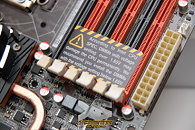Friday, October 3rd 2008

Theory of DDR3 Voltage Limitations for Bloomfield Gains Ground
Nehalem does promise to be a processor to look out for, it would be Intel's next installment, post the successful Core 2 series processors. This time however, Intel made a core modification with the way the system handles memory. The Bloomfield processors house a massive 192-bit wide memory controller for supporting tri-channel DDR3 memory. It however was found that the controller could bring in limitations to the DIMM voltages that the system could support.
The retail version of ASUS P6T Deluxe OC Palm Edition motherboard was unboxed by XFastest. Being the retail product, as usually, it comes with precautionary labels attached to parts of the motherboard. The one that covers the 6 DDR3 DIMM slots reads:
The retail version of ASUS P6T Deluxe OC Palm Edition motherboard was unboxed by XFastest. Being the retail product, as usually, it comes with precautionary labels attached to parts of the motherboard. The one that covers the 6 DDR3 DIMM slots reads:
According to Intel CPU SPEC, DIMMs with voltage setting over 1.65V may damage the CPU permanently. We recommend you to install DIMMs with voltage setting below 1.65V.It could have implications on the current DDR3 memory market as well as you, if you happen to have DDR3 modules, which you plan to retain for use in the future platform, that operate above the said voltage. It also means that in the near future, we could be seeing memory sticks that facilitate overclocking at much lower voltages. From a technology standpoint, companies such as Samsung, Elpida, Micron, etc., are working on releasing DRAM chips based on newer silicon fabrication technologies, that operate at lower voltages.

89 Comments on Theory of DDR3 Voltage Limitations for Bloomfield Gains Ground
We should be seeing timing of 7-7-7 or lower and voltage of 1.5V DDR3 1600. Instead we are seeing 9-9-9 at 1.8V+ or 7-7-7 at 1.8V+. It shouldn't be that way if they want to convince people that DDR3 is next gen. That's why it's not doing well IMO.
Wonder when we'll see DDR3 modules with 6-pin PCIE power connectors? :roll:
Regardless of what voltage AMD can accept it shouldn't be that way. If PSC can bring 4gigs of DDR2 of memory close to JEDEC there is no reason why everyone else can't do the same with DDR3. This would bring the difference down from whopping (1.5V - 1.9V =) 0.4V to 0.1V using 4Gigs at 7-7-7!
It's funny how we went from 2Gigs of DDR2 at 2.2V (where 2.1V is more common) down to 4Gigs of ram below 2.0V! But can't see the same innovation with DDR3 which is suppose to be next gen!
im sure memory companies will make ram that complies but jeeez.... it would be better for intel to unlock this BS voltage link.
www.techpowerup.com/72319/Elpida_Buffalo_Release_Prototype_DDR3_2400_MHz_Memory.html